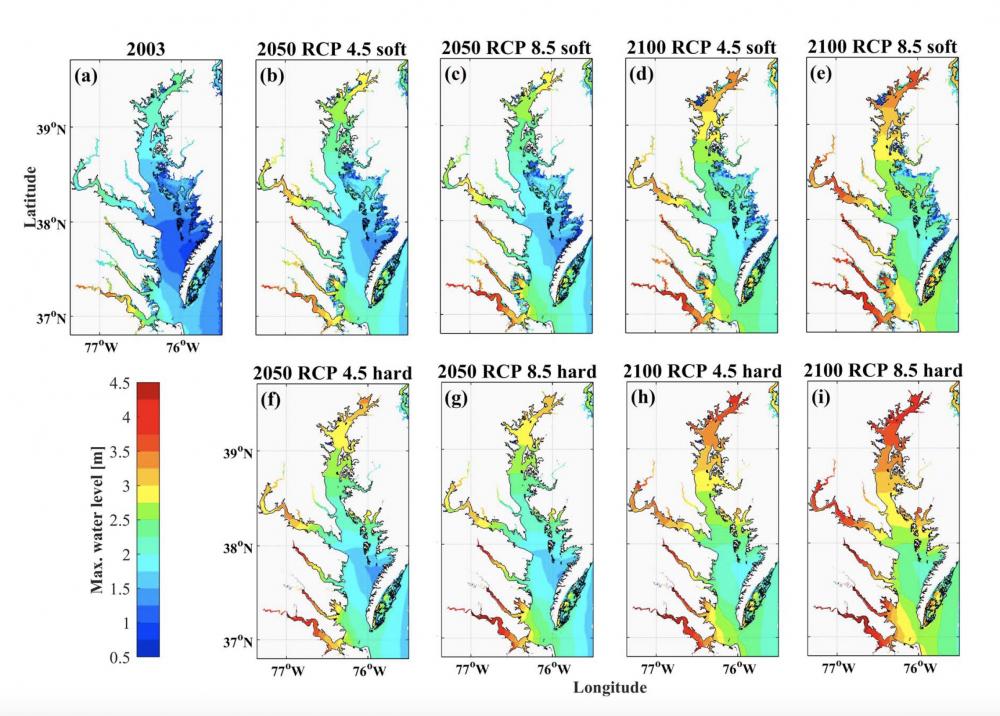The recently published work of two oceanographers at the University of Maryland Center for Environmental Science’s Horn Point Laboratory (HPL) displays how ocean warming, sea level rise, and the hardening of shorelines will lead to increased storm surges for Baltimore and other parts of the upper Chesapeake Bay.
The research article by HPL Professor Ming Li and Assistant Research Scientist Fan Zhang was made available in a publication from AGU (American Geophysical Union).

HPL Professor Ming Li and Assistant Research Scientist Fan Zhang.
Using the climate model projections to drive regional atmosphere‐ocean models, Li and Zhang investigated how ocean warming, sea level rise, and coastline management affect storm surge in the semi enclosed Chesapeake Bay. The results: Warmer ocean surface produces stronger storms and leads to higher storm surge throughout the Chesapeake Bay. In addition, the hardening of shorelines will further raise the peak surge height in areas such as Baltimore, which reside in the upper parts of the Chesapeake.
“Although ocean warming and sea level rise are global phenomena, what local people do with coastline management could make a big difference to storm surge and flooding in a semi-enclosed Bay like the Chesapeake Bay,” said Ming Li.
The scientists used Hurricane Isabel (2003) as a case study, showing projections of climatic conditions for 2050 and 2100. While ocean warming is shown to be the main driver of storm surge amplification in the future climate, energy budget analysis also shows that allowing flooding over low‐lying areas leads to a significant energy loss and reduction in the storm surge height in the estuary.

AGU graphic
The research notes the challenges involved in managing coastal inundation risk in the Chesapeake Bay due to its long and convoluted coastlines. Given the large difference in the storm surge height between soft and hard shorelines, coastal communities around the Bay need to explore different mitigation and adaptation strategies to deal with coastal inundation.
For example, allowing for the low‐lying coastal plains of Maryland’s Eastern Shore to be flooded – and assisting the affected coastal communities in elevating their houses and/or migrating to higher grounds – could significantly reduce the storm surge at the metropolitan cities located further upstream.
“By retreating from low-lying rural areas, surge height in Baltimore and Washington, D.C could be reduced by 1.5 feet. The coastal communities around the Chesapeake Bay need to engage in discussions about how to collectively mitigate the flood risk,” said Li. “A potential cost-effective management strategy might be to assist low-lying rural communities to relocate rather than building higher seawalls around the cities.”
It was also noted that while sea level rise will add to the total water level, it only has a moderate effect on the storm surge height itself.
HORN POINT LABORATORY
From the banks of the Choptank River on Maryland’s Eastern Shore, scientists engage in world-renowned research in oceanography, water quality, restoration of sea grasses, marshes and shellfish, and expertise in ecosystem modeling. www.umces.edu/hpl
Don’t miss the latest! You can subscribe to The Chestertown Spy‘s free Daily Intelligence Report here



Write a Letter to the Editor on this Article
We encourage readers to offer their point of view on this article by submitting the following form. Editing is sometimes necessary and is done at the discretion of the editorial staff.